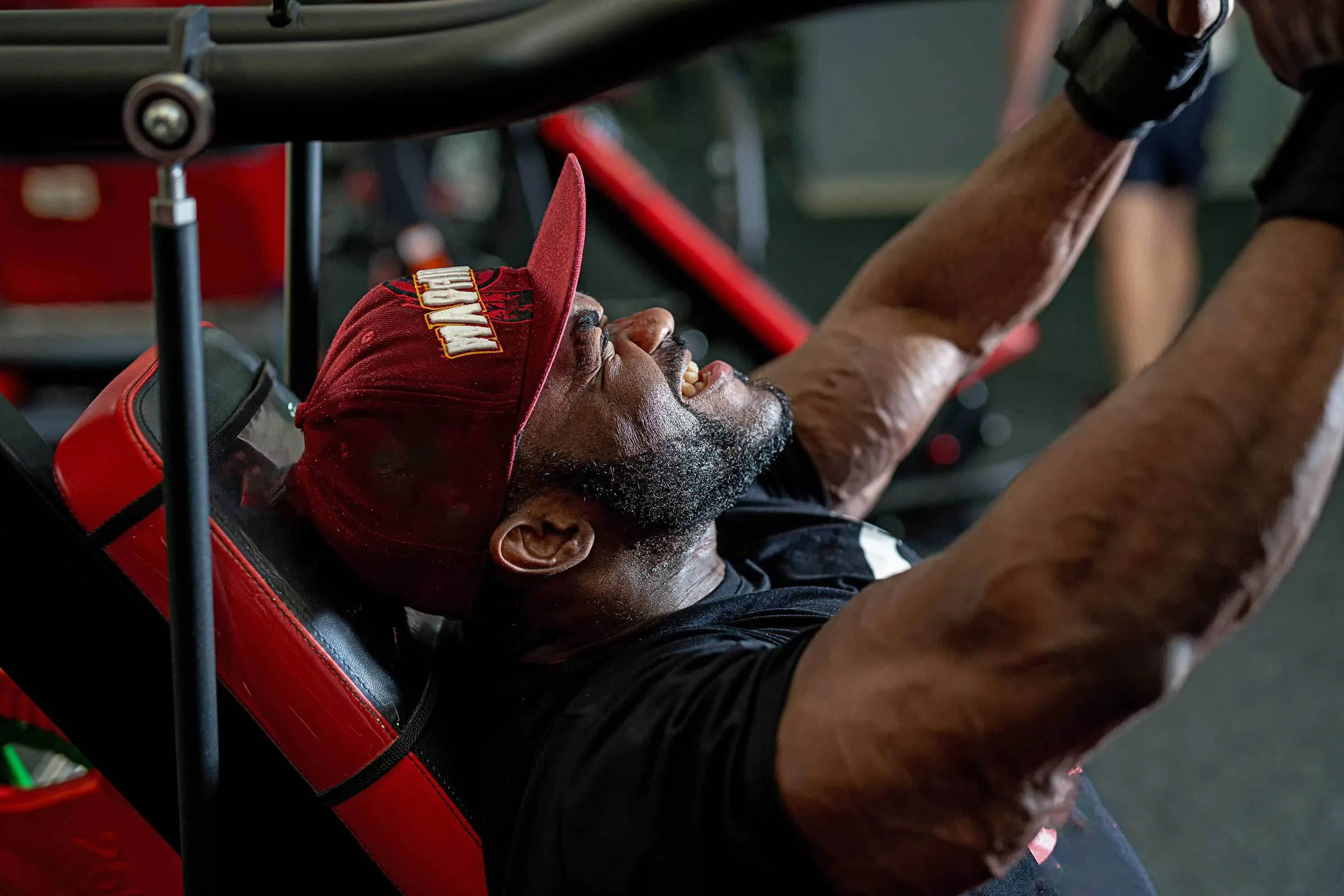Volume vs Time Under Tension for Hypertrophy
TOPIC: Strength & Conditioning
How many reps should you do for muscle growth? How can you get a better pump from a movement that usually doesn’t make you sore? Tweaking your program to include high-volume and tempo sets is sure to get you the kind of size and strength you want from your training. Learn about it!
Joseph Lucero, owner of Harvesting Strength, is a powerlifter and strongman coach with years of practical S&C experience in high school, collegiate, and professional settings. Check out his guide on the incline bench and its variations.

Written By
Joseph Lucero
Programs
Website

Meathead Status Doesn’t Just Happen
Strength training has become more popular with the surge of social media. Seeing humans conquer feats that once seemed inconceivable has inspired many to tackle the world of strength one muscle fiber at a time. It’s safe to say that for us strength enthusiasts, we generally want to become bigger, stronger, and faster.
Getting bigger and stronger sounds great. But how do you actually grow muscular density? We need to lift heavy and lift often, right?
Gaining muscle mass isn’t that simple, especially for seasoned lifters. We need to differentiate our training and use other helpful tactics to elicit better muscle-growth results.
Muscular hypertrophy often begins with training volume (high number of reps) and/or time under tension (amount of tempo within a given rep). Both are very beneficial styles of training, but many times are not exclusive to each other.
So what’s the difference between the two, how do they work, and which do I choose for my training?
As with most things in life, it depends — so grab your cup of caffeine and strap in tight for a ride into the mayhem of how to build massive muscle mass!
Why build size?
Embracing muscular hypertrophy comes with many benefits. Whether it has to do with protecting your joints, reducing injury, or enhancing your quality of life, the idea of building more muscle mass has too many benefits that can’t be overlooked.
A sure-fire way to become a stronger, faster athlete is to grow bigger muscle fibers.
How so? It’s all about the growth of your muscle tissues. You won’t elevate your speed if you don’t have enough muscle mass to improve power output for faster contractions. You will also lack gains in strength if you don’t have enough muscle mass to meet the demands of the weight loaded on the bar.
Building size and getting bigger can seem intimidating and undesirable as it could be misconstrued as gaining a “larger” anatomy. But with the right body composition goals, you can gain muscle mass without putting on a ton of weight. Obviously this depends on your frame and biology, but for our purposes, let’s focus on muscle growth.
Volume and Time Under Tension: What’s the Difference? Is One Better?
In order to understand the difference between training volume and time under tension, it’s best to define both styles of training. Although they have their differences, they do share a commonality – both volume and time under tension fatigue the muscle enough to elicit a spike in the body’s anabolic (muscle building) hormones.
This is the process of “muscular hypertrophy” or the growth of muscle tissue in the body. When you resistance train to exhaustion, you are provoking an anabolic response in the body to build bigger and stronger muscles during recovery.
Let’s define both styles of training and understand how they differentiate from each other.
Volume Training
Volume training is characterized by a high workload and an emphasis on the total number of repetitions performed during a training session. Those who advocate for volume training argue that this approach induces significant hypertrophic adaptations. The cumulative fatigue experienced during high volume training leads to metabolic stress and muscle damage, two factors associated with hypertrophic responses.
One of the great reasons to use volume training is that it can be measurable and consistent.
If you did 20 reps of 100 pounds this week, you can tell yourself next week to do 30 reps of 100 pounds to overload the muscle, see how it responds and if you can continue to overload that movement for the following weeks.
Currently, we view volume with a quantitative measurement, using numbers to track performance. But the numbers don’t measure the quality of each movement.
What if I did 100 bicep curls with complete range of motion while my workout partner does 100 half-ass reps? We both did 100 reps! But I put more effort into my working set than my partner, so I’ll likely gain the most benefit. Something to keep in mind for volume training.
For time under tension, we use a more qualitative approach as we are evaluating the quality of each movement.
Embracing a qualitative and quantitative approach to training will net you the best results.
Time Under Tension Training
Time under tension (also abbreviated as “TUT”) focuses on prolonging the duration of each repetition, emphasizing muscle contraction and maximizing the time muscles spend under load. Advocates for TUT argue that it enhances muscle fiber recruitment and promotes significant hypertrophic adaptations. And you know what? They aren’t wrong!
A study by Burd et al. (2012) compared TUT training with traditional resistance training. This study found prolonged muscle TUT affects protein synthesis and recovery, highlighting the importance of not only exercise volume but also manipulating the eccentric loading. This increases muscle fatigue. Elevating fatigue provides an environment for the muscle to grow.
The idea of a prolonged contraction shows many benefits to muscular hypertrophy. Ultimately, using TUT to fatigue your muscles means you won’t have to load as much weight. Using lighter weights can spare the body’s joints and ligaments from injury, and actually make them more resilient over time.
Which Form of Training is Better?
When it comes to choosing volume or TUT, it truly depends on you as an athlete and your goals.
The ideal answer is to use both volume and TUT strategically to elicit the best anabolic response to exercise.
Remember, building muscle requires fatiguing/exhausting the working muscles. When you incorporate both volume and TUT, you’re providing both quantitative and qualitative forms of training that will be far superior than merely focusing on one form over the other.
When to Use Volume or TUT
I generally recommend newer athletes focus on volume instead of TUT, because volume is a measurable approach to training and your progressions can be documented easily.
There are other tactics within volume training to further fatigue the working muscles for better results. One of the best ways to do this is through mega sets for multiple reps and limited rest.
But what about someone who can’t handle high volume due to injury or joint issues? This population might respond better to TUT tactics. TUT training prolongs movement to exaggerate contractions for more exhaustion to the muscle. That exhaustion is the mechanism for triggering growth and development.
An added benefit to TUT is refining your movement patterns and improving your motor control through a lift.
Let’s get into mega sets, drop sets, tempo training and the “mind muscle connection” next.

How to Train Using Volume
Volume training can be done with traditional programming, mega sets, or drop sets for massive exhaustion to the working muscles.
Traditional Volume
Normal high-volume programming might be training that has athletes performing 12-20 reps within a working set. There might be 2-5 working sets.
Over time, you add either more sets or more reps to progressively overload the athlete and make them work harder based on performance and capability. This seems to be an effective progression for most new to intermediate athletes who respond well to normal high-volume training tactics.
Mega Sets
A mega set involves performing a ton of volume consecutively and getting limited rest to keep the muscle fatigued for a prolonged time. You might perform 50,100, 200 reps as quickly as possible. For example:
- Seated Leg Extension Machine: 1×100 reps with 10 second breaks once you hit fatigue
The challenge is to figure out an amount of weight you can perform 20 reps with, then take it to failure. Every time you hit failure, you get a 10 second break for recovery before continuing. This type of training helps keep things measurable and consistent.
Drop Sets
A drop set is a weightlifting technique where you perform an exercise set to failure, then immediately reduce the weight and continue the set without resting. This process involves using a heavy load initially, then decreasing the weight in subsequent sets. The purpose of a drop set is to push muscles to their limits, inducing muscle fatigue and promoting hypertrophy.
You could do a single drop set or multiple drop sets within a working set. Remember, the drop set happens immediately. Don’t perform to failure, walk around the gym and then continue with the same exercise — it needs to be immediate.
- Chest Press Machine: 3×10 reps with a double drop set. Each drop set should be around 30% of the previous working set.
If you were to do 100 pounds on the chest press, that means your first working set is 100 for 10 reps, then dropping to 70 pounds to failure, then dropping to 50 pounds to failure. You don’t need to drop by 30% exactly, but you do need to pick a consistent percentage that allows you to perform a substantial amount of volume for growth.
How to Train Using Time Under Tension
TUT focuses on prolonging the duration of each repetition, emphasizing muscle contraction and maximizing the time muscles spend under load. By extending the duration of each rep, TUT training boosts muscle fiber recruitment and activation. This prolonged muscle engagement stimulates greater mechanical tension and metabolic stress, facilitating muscle growth.
TUT is done with a specific tempo for the start, eccentric, pause, and concentric phases of each movement. TUT is much lighter in volume, but the exaggeration of each phase of movement is what makes it so hard. An example of how to use TUT with an exercise would be:
Tempo Cable Bicep Curls: 3-2-5-0 for 3 x 10 reps
The sequence of numbers 3-2-5-0 corresponds to the time in seconds you count for each phase of the cable bicep curl. The curl starts with your elbows extended and the weight at the bottom. The first number “3” means the weight needs to be curled upward within 3 seconds.
The “2” has to do with the pause at the top, squeezing the biceps at the top of the cable curl to further exhaust the muscle. The “5” is time spent lowering the curl, bringing the weight down in a 5-second count. The final number “0” means there’s no pause at the bottom of the curl before going straight into the next rep.
Each movement will usually have four phases and each exercise can be altered in tempo based on your preference. I would not recommend doing more than 10 consecutive reps, or using a tempo longer than 5-6 seconds.
For more, see Understanding Tempo Training for Maximum Strength Gains.
Mind-Muscle Connection
This seems to be a delicate topic for many, as most will ask… does the mind-muscle connection truly exist?
Well, based on my professional expertise and experience with movement, yes! The mind-muscle connection truly does exist. TUT training emphasizes the mind-muscle connection, requiring conscious control and focus on the targeted muscles during each repetition. This heightened awareness enhances muscle activation, quality of contraction, and ultimately, hypertrophic responses.
A study published in the Journal of Strength and Conditioning Research by Schoenfeld et al. (2019) found that participants who focused on the mind-muscle connection during bicep curls exhibited significantly higher muscle activity compared to those who performed the exercise without such focus. These findings highlight the importance of consciously engaging the targeted muscles for optimal muscle fiber recruitment.
So, what does TUT have to do with the mind-muscle connection? During a tempo-based movement, the extra time could allow your mind to participate more in order to correct, adjust, and enhance your mechanics. So if you are performing a tempo based exercise, allow yourself to live in that moment and really focus on the muscles being recruited. The more you focus, the more you can enhance the contraction.
Sample Program
It’s one thing to learn about a concept in movement performance, but it is another thing to put it into action! Below, I have outlined an idea of how to create a workout routine that incorporates both volume and TUT tactics for hypertrophic results.
Back and Bicep Workout
| Exercise | Sets | x | Reps | Notes |
| Bent Over Rows | 3 | x | 10 | Start off heavy with a focus on strength |
| Eccentric Pull Ups | 5 | x | 6 | Do a 5-6 second eccentric from the top of the pull up |
| Tempo Cable Hammer Curls 3-2-5-0 | 3 | x | 10 | 3 seconds up, 2 second squeeze at the top, 5 seconds down, 0 second pause at the bottom of the curl |
| DB Shrugs | 3 | x | 20 | Short rest breaks |
| Preacher Machine Bicep Curls | 1 | x | 100 | Start off with a weight you can perform around 20 reps with. Work to failure, and then take a 10 second break. If you take more than 3 breaks, DROP the intensity by 30% each break until you reach 100 reps. |
Final Thoughts
Building muscle mass through hypertrophy tactics like volume training and time under tension (TUT) offers numerous benefits. While the common goal is to become bigger, faster, and stronger, muscle growth is the foundation for achieving these goals.
Volume training emphasizes high workloads and the total number of repetitions, promoting significant hypertrophic adaptations through metabolic stress and muscle damage. On the other hand, TUT training prolongs muscle contractions, maximizing muscle fiber recruitment and promoting growth.
Combining both volume and TUT training is ideal, as it provides a quantitative and qualitative approach to training. Understanding these strategies as tools in your arsenal means building impressive muscle mass effectively and efficiently
Sources
- Burd NA, Andrews RJ, West DW, Little JP, Cochran AJ, Hector AJ, Cashaback JG, Gibala MJ, Potvin JR, Baker SK, Phillips SM. Muscle time under tension during resistance exercise stimulates differential muscle protein sub-fractional synthetic responses in men. J Physiol. 2012 Jan 15;590(2):351-62. doi: 10.1113/jphysiol.2011.221200. Epub 2011 Nov 21. PMID: 22106173; PMCID: PMC3285070.
- Schoenfeld BJ, Vigotsky A, Contreras B, Golden S, Alto A, Larson R, Winkelman N, Paoli A. Differential effects of attentional focus strategies during long-term resistance training. Eur J Sport Sci. 2018 Jun;18(5):705-712. doi: 10.1080/17461391.2018.1447020. Epub 2018 Mar 13. PMID: 29533715.
Find Your Perfect Training Plan
Sometimes all you need to reach your destination on your fitness journey is an expert guide. Look no further, we've got you covered. Browse from thousands of programs for any goal and every type of athlete.
Try any programming subscription FREE for 7 days!
Related Articles
You May Also Like...
How To Zercher Squat: One Exercise To Rule Them All
We all want that golden ticket. The one-size-fits-all exercise and perfect program. You know – the one that makes us look like the Hulk as long as we follow that program to the T. Well folks, that all sounds great. But in reality, we know there is no one-size-fits-all...
What Does Paralympic Strength Training Look Like?
Paralympians undergo rigorous training when preparing for the Paralympic Games. While the Paralympics only last about two weeks, getting ready takes place all year, as these athletes are among the most dedicated in the world. Here’s how people with disabilities...
Top 6 Exercises for Managing Shoulder Injuries
What to Do for an Injured Shoulder After 6 years of coaching at the highest levels across multiple disciplines, the most common issues I see in my sports therapy clinic have to do with the shoulder. Statistics show us that shoulders are the most commonly injured area...
How To Zercher Squat: One Exercise To Rule Them All
I have a secret weapon exercise that will get us really close; it has a lot of bang for its buck. It builds massive quads, big glutes, a wide back, and some awesome biceps. Exactly what every athlete needs.
What Does Paralympic Strength Training Look Like?
Paralympians undergo rigorous training when preparing for the Paralympic Games. While the Paralympics only last about two weeks, getting ready takes place all year, as these athletes are among the most dedicated in the world. Here’s how people with disabilities...


Want more training content?
Subscribe
For Coaches
For Athletes
About
Support
Training Lab
Access the latest articles, reviews, and case studies from the top strength and conditioning minds in the TH Training Lab!
Made with love, sweat, protein isolate and hard work in Denver, CO
© 2024 TrainHeroic, Inc. All rights reserved.













